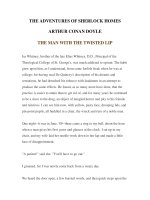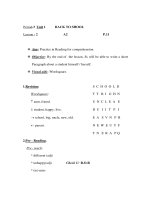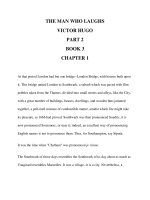3 6 1 the places where we live
Bạn đang xem bản rút gọn của tài liệu. Xem và tải ngay bản đầy đủ của tài liệu tại đây (2.36 MB, 10 trang )
Fascinating Facts
• The Nile River in Egypt is the world’s longest
river, but the Amazon River in Brazil moves
the most water.
• The world’s largest freshwater lake is Lake
Baikal in Russia.
• The highest temperature ever recorded in the
world is 136°F (58°C) in the Sahara.
Genre
Nonfiction
Comprehension Skill
Main Idea
and Details
Text Features
• Glossary
• Headings
Scott Foresman Social Studies
ISBN 0-328-14822-9
ì<(sk$m)=beic g< +^-Ä-U-Ä-U
In this book you will read about different
places. Each place has a different
way of life.
Write to It!
Vocabulary
community
transportation
Write two or three sentences about your
community and how your life is affected by
the land around you.
Write your sentences on a separate sheet
of paper.
Photographs
Every effort has been made to secure permission and provide appropriate credit for photographic material. The publisher deeply
regrets any omission and pledges to correct errors called to its attention in subsequent editions.
Unless otherwise acknowledged, all photographs are the property of Scott Foresman, a division of Pearson Education.
Photo locators denoted as follows: Top (T), Center (C), Bottom (B), Left (L), Right (R), Background (Bkgd)
ISBN: 0-328-14822-9
Copyright © Pearson Education, Inc.
All Rights Reserved. Printed in the United States of America. This publication is protected
by Copyright, and permission should be obtained from the publisher prior to any prohibited
reproduction, storage in a retrieval system, or transmission in any form by any means,
electronic, mechanical, photocopying, recording, or likewise. For information regarding
permission(s), write to: Permissions Department, Scott Foresman, 1900 East Lake Avenue,
Glenview, Illinois 60025.
1 2 3 4 5 6 7 8 9 10 V0G1 14 13 12 11 10 09 08 07 06 05
Opener: (C) ©Getty Images, (T) ©Getty Images, (B) ©Getty Images
2 (C) ©Getty Images, (B) ©Getty Images
3 ©Ronnie Kaufman/Corbis
4 ©Stephen Bond/Alamy.com
5 ©James Marshall/Corbis
Editorial Offices: Glenview, Illinois • Parsippany, New Jersey • New York, New York
6 ©Royalty-Free/Corbis
7 ©Bob Krist/Corbis
Sales Offices: Needham, Massachusetts • Duluth, Georgia • Glenview, Illinois
8 ©AP/Wide World Photos
Coppell, Texas • Sacramento, California • Mesa, Arizona
9 ©Keith Wood/Getty Images
10 ©Frans Lemmens/Getty Images
12 ©Royalty-Free/Corbis
13 ©Royalty-Free/Corbis
14 ©Royalty-Free/Corbis
15 ©Getty Images
A community is a place where people
live, work, and have fun together. A
community’s location, climate, and
resources affect the people who live there.
In cold climates, for example, people learn
how to stay warm.
Where We Live
Living near an ocean is different than
living in a desert. Deserts and oceans can
both have sand. Each have different kinds
of weather, animals, and plants, though.
2
3
Living Near Water
Towns and cities are often located near
lakes, rivers, streams, and oceans. Oceans
are huge bodies of salt water. There are
four oceans on Earth. Most of the fish that
people eat are caught in an ocean.
There were not many roads in the past.
Rivers were often used for transportation,
or carrying things or people from place
to place. Rivers are large streams of fresh
water that flow into another body of water.
Farmers settled near rivers so they could use
the water for their crops.
4
5
Lakes are bodies of water surrounded by
land. Many people enjoy living near lakes.
Some people enjoy using lakes for canoeing,
swimming, and fishing.
Some people live on islands. An island is
land that is surrounded by water.
Some islands are connected to other lands
by bridges. Some islands can be reached
only by plane or by boat.
6
7
Living near water can sometimes be
dangerous. Floods and storms can damage
buildings. People should know how to work
and play safely around water.
There are many reasons people choose
to live near water. Lakes and rivers provide
water for drinking, cooking, and washing.
Fishing in rivers and oceans provides food.
8
9
Living in the Desert
Deserts are dry places that get less than
ten inches of rain in a year. Desert weather
can be extreme. People who live in a desert
must protect themselves from the sun, cold,
and wind.
10
Some deserts are hot in the daytime and
cold at night. Some deserts are always cold.
Antarctica is a desert. It has lots of ice and
cold weather. Rain or snow is uncommon
there.
11
Today, roads and tunnels make it easier
to travel in and through the mountains. In
mountain valleys there may be land that is
good for growing crops.
Living Near Mountains
Mountains are tall landforms that rise into
peaks or tops. Many mountains have snow
on their peaks all year. Water from melted
snow runs down the mountain and flows
into streams and rivers. This gives people
fresh water to drink.
12
13
All communities share their surroundings
with plants and animals. Different plants
and animals live in different places. They
get used to their surroundings—just like
people.
Visiting another place can be exciting.
Food, clothes, and transportation can be
different depending on where you live.
Earth’s resources are important to how
we live.
14
15
In this book you will read about different
places. Each place has a different
way of life.
Glossary
community a place where people live,
work, and have fun together
transportation a way of carrying things
Vocabulary
or people from place to place
community
transportation
Write to It!
Write two or three sentences about your
community and how your life is affected by
the land around you.
Write your sentences on a separate sheet
of paper.
Photographs
Every effort has been made to secure permission and provide appropriate credit for photographic material. The publisher deeply
regrets any omission and pledges to correct errors called to its attention in subsequent editions.
Unless otherwise acknowledged, all photographs are the property of Scott Foresman, a division of Pearson Education.
Photo locators denoted as follows: Top (T), Center (C), Bottom (B), Left (L), Right (R), Background (Bkgd)
ISBN: 0-328-14822-9
Copyright © Pearson Education, Inc.
All Rights Reserved. Printed in the United States of America. This publication is protected
by Copyright, and permission should be obtained from the publisher prior to any prohibited
reproduction, storage in a retrieval system, or transmission in any form by any means,
electronic, mechanical, photocopying, recording, or likewise. For information regarding
permission(s), write to: Permissions Department, Scott Foresman, 1900 East Lake Avenue,
Glenview, Illinois 60025.
16
1 2 3 4 5 6 7 8 9 10 V0G1 14 13 12 11 10 09 08 07 06 05
Opener: (C) ©Getty Images, (T) ©Getty Images, (B) ©Getty Images
2 (C) ©Getty Images, (B) ©Getty Images
3 ©Ronnie Kaufman/Corbis
4 ©Stephen Bond/Alamy.com
5 ©James Marshall/Corbis
6 ©Royalty-Free/Corbis
7 ©Bob Krist/Corbis
8 ©AP/Wide World Photos
9 ©Keith Wood/Getty Images
10 ©Frans Lemmens/Getty Images
12 ©Royalty-Free/Corbis
13 ©Royalty-Free/Corbis
14 ©Royalty-Free/Corbis
15 ©Getty Images









